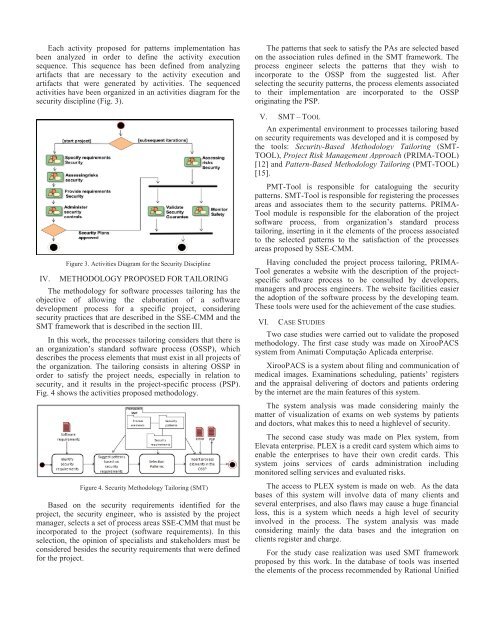Using Security Patterns to Tailor Software Process - Knowledge ...
Using Security Patterns to Tailor Software Process - Knowledge ...
Using Security Patterns to Tailor Software Process - Knowledge ...
You also want an ePaper? Increase the reach of your titles
YUMPU automatically turns print PDFs into web optimized ePapers that Google loves.
Each activity proposed for patterns implementation has<br />
been analyzed in order <strong>to</strong> define the activity execution<br />
sequence. This sequence has been defined from analyzing<br />
artifacts that are necessary <strong>to</strong> the activity execution and<br />
artifacts that were generated by activities. The sequenced<br />
activities have been organized in an activities diagram for the<br />
security discipline (Fig. 3).<br />
Figure 3. Activities Diagram for the <strong>Security</strong> Discipline<br />
IV. METHODOLOGY PROPOSED FOR TAILORING<br />
The methodology for software processes tailoring has the<br />
objective of allowing the elaboration of a software<br />
development process for a specific project, considering<br />
security practices that are described in the SSE-CMM and the<br />
SMT framework that is described in the section III.<br />
In this work, the processes tailoring considers that there is<br />
an organization’s standard software process (OSSP), which<br />
describes the process elements that must exist in all projects of<br />
the organization. The tailoring consists in altering OSSP in<br />
order <strong>to</strong> satisfy the project needs, especially in relation <strong>to</strong><br />
security, and it results in the project-specific process (PSP).<br />
Fig. 4 shows the activities proposed methodology.<br />
Figure 4. <strong>Security</strong> Methodology <strong>Tailor</strong>ing (SMT)<br />
Based on the security requirements identified for the<br />
project, the security engineer, who is assisted by the project<br />
manager, selects a set of process areas SSE-CMM that must be<br />
incorporated <strong>to</strong> the project (software requirements). In this<br />
selection, the opinion of specialists and stakeholders must be<br />
considered besides the security requirements that were defined<br />
for the project.<br />
The patterns that seek <strong>to</strong> satisfy the PAs are selected based<br />
on the association rules defined in the SMT framework. The<br />
process engineer selects the patterns that they wish <strong>to</strong><br />
incorporate <strong>to</strong> the OSSP from the suggested list. After<br />
selecting the security patterns, the process elements associated<br />
<strong>to</strong> their implementation are incorporated <strong>to</strong> the OSSP<br />
originating the PSP.<br />
V. SMT – TOOL<br />
An experimental environment <strong>to</strong> processes tailoring based<br />
on security requirements was developed and it is composed by<br />
the <strong>to</strong>ols: <strong>Security</strong>-Based Methodology <strong>Tailor</strong>ing (SMT-<br />
TOOL), Project Risk Management Approach (PRIMA-TOOL)<br />
[12] and Pattern-Based Methodology <strong>Tailor</strong>ing (PMT-TOOL)<br />
[15].<br />
PMT-Tool is responsible for cataloguing the security<br />
patterns. SMT-Tool is responsible for registering the processes<br />
areas and associates them <strong>to</strong> the security patterns. PRIMA-<br />
Tool module is responsible for the elaboration of the project<br />
software process, from organization’s standard process<br />
tailoring, inserting in it the elements of the process associated<br />
<strong>to</strong> the selected patterns <strong>to</strong> the satisfaction of the processes<br />
areas proposed by SSE-CMM.<br />
Having concluded the project process tailoring, PRIMA-<br />
Tool generates a website with the description of the projectspecific<br />
software process <strong>to</strong> be consulted by developers,<br />
managers and process engineers. The website facilities easier<br />
the adoption of the software process by the developing team.<br />
These <strong>to</strong>ols were used for the achievement of the case studies.<br />
VI. CASE STUDIES<br />
Two case studies were carried out <strong>to</strong> validate the proposed<br />
methodology. The first case study was made on XirooPACS<br />
system from Animati Computação Aplicada enterprise.<br />
XirooPACS is a system about filing and communication of<br />
medical images. Examinations scheduling, patients’ registers<br />
and the appraisal delivering of doc<strong>to</strong>rs and patients ordering<br />
by the internet are the main features of this system.<br />
The system analysis was made considering mainly the<br />
matter of visualization of exams on web systems by patients<br />
and doc<strong>to</strong>rs, what makes this <strong>to</strong> need a highlevel of security.<br />
The second case study was made on Plex system, from<br />
Elevata enterprise. PLEX is a credit card system which aims <strong>to</strong><br />
enable the enterprises <strong>to</strong> have their own credit cards. This<br />
system joins services of cards administration including<br />
moni<strong>to</strong>red selling services and evaluated risks.<br />
The access <strong>to</strong> PLEX system is made on web. As the data<br />
bases of this system will involve data of many clients and<br />
several enterprises, and also flaws may cause a huge financial<br />
loss, this is a system which needs a high level of security<br />
involved in the process. The system analysis was made<br />
considering mainly the data bases and the integration on<br />
clients register and charge.<br />
For the study case realization was used SMT framework<br />
proposed by this work. In the database of <strong>to</strong>ols was inserted<br />
the elements of the process recommended by Rational Unified
















